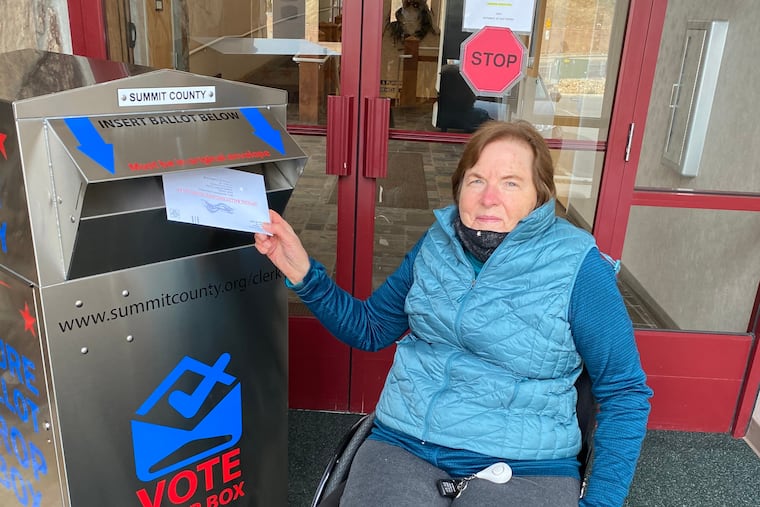I voted proudly this election as someone with a disability | Opinion
Voter turnout among citizens with disabilities surged in 2018. Politicians neglect us at their peril.

I voted Friday proudly, bringing all my life experiences with me. I cast my ballot as visibly as I could and will bring others along with me.
When I was 17, after a childhood spent in a first-ring Philly suburb (Lansdowne) and then the Main Line (Villanova), I became spinal cord-injured during a camp game in New Hampshire. In 1965, I joined a club we all might join, no matter our ethnicity or class: the disability club.
It took me years of maturing and inhabiting the lived experience of being treated as “other” to become conscious of the reality. This is a club no one sets out to join. Yet, your membership is just a heartbeat away from a stroke, a slip away from a fall, a dive away if the water is too shallow, a birth away if you are born with any number of conditions, an illness away, a glance away, a bullet away, and on and on.
» READ MORE: 1 in 6 Pennsylvania voters has a disability. Why don’t candidates campaign for their support?
Recently, I joined the leadership team of the Democratic National Committee’s Disability Council. Currently, our job is to organize people with disabilities and their allies in battleground states and to increase Democratic disability civic participation in general.
We are seeing some progress, like the Democratic National Convention that made what often is an invisible minority group visible. The 13-year-old boy with a stutter who spoke evoked Joe Biden’s personal history with this condition. Sen. Tammy Duckworth (D., Ill.) gave us the visual message of disability, introducing herself by video with her prosthetic legs visible and wheelchair nearby as she spoke passionately of military service, sacrifice, and leadership.
By contrast, when Donald Trump mocked the physical appearance of a New York Times reporter with a disability in 2015, I and myriads of others cringed. In fact, in a Bloomberg poll the summer after, likely voters chose this as Trump’s worst offense.
“Veiled or no, the clear ‘fear or awkwardness energy’ of strangers is easy to pick up. Pity is the other end of the binary to hostility."
I haven’t experienced much of this outright hostility toward people with disabilities. Yet, ask anyone who is blind, uses a wheelchair, is deaf, or somehow different. We understand. Veiled or no, the clear “fear or awkwardness energy” of strangers is easy to pick up. Pity is the other end of the binary to hostility. Either way, discrimination is the result. When I was a White House fellow in 1979, someone I interviewed with during the placement process was polite when I met him, but apparently told his aides he couldn’t work with a person who used a wheelchair, even though it was illegal to discriminate against people with disabilities in the federal government. The Americans with Disabilities Act expanded our civil rights in 1990. However, people’s attitudes still lag behind the law.
I can’t count the times I have sat in my wheelchair on the other side of food counters and been ignored. When I speak up, invariably the person working the counter says they thought I was with whomever I was positioned next to. Or how often I have handed a vendor money, only to have that person return the change or tickets to the able-bodied person standing next to me. My experiences of invisibility and dismissal in these moments extend to the invisibility of people with disabilities as a whole. How frequently do you hear people with disabilities mentioned when politicians or speakers give their litany of marginalized groups they intend to include? Not enough, is my answer, given we are the U.S.’s largest minority group.
» READ MORE: Nondisabled people ran with work-from-home accessibility. Now do the same for voting. | Opinion
But this affinity group is growing in recognition and stature. Voter turnout surged by 8.5 points in 2018 among citizens with disabilities relative to the 2014 midterm elections, per a report from Rutgers University’s School of Management and Labor Relations. If people with disabilities voted at the same rate as people without disabilities who have the same demographic characteristics, there would be about 2.35 million more voters. In 2018, among the 108 million voters without disabilities, 10.2 million shared their household with a person with a disability. Added to voters with disabilities, there were 24.5 million voters in disability households, equaling 20% of all voters. We as a nation can’t afford not to pay attention to this group.
I know what it means to be a marginalized citizen. So do others with a disability. For the rest, I invite you to be an ally and support this identity group. Help us by getting out the vote. Campaigns and party leaders, don’t take us for granted. The disability vote could be the deciding factor for elections up and down the ballot.
Elizabeth Fetter has been a disability advocate for over 50 years and received her MFA from Vermont College of Fine Arts.